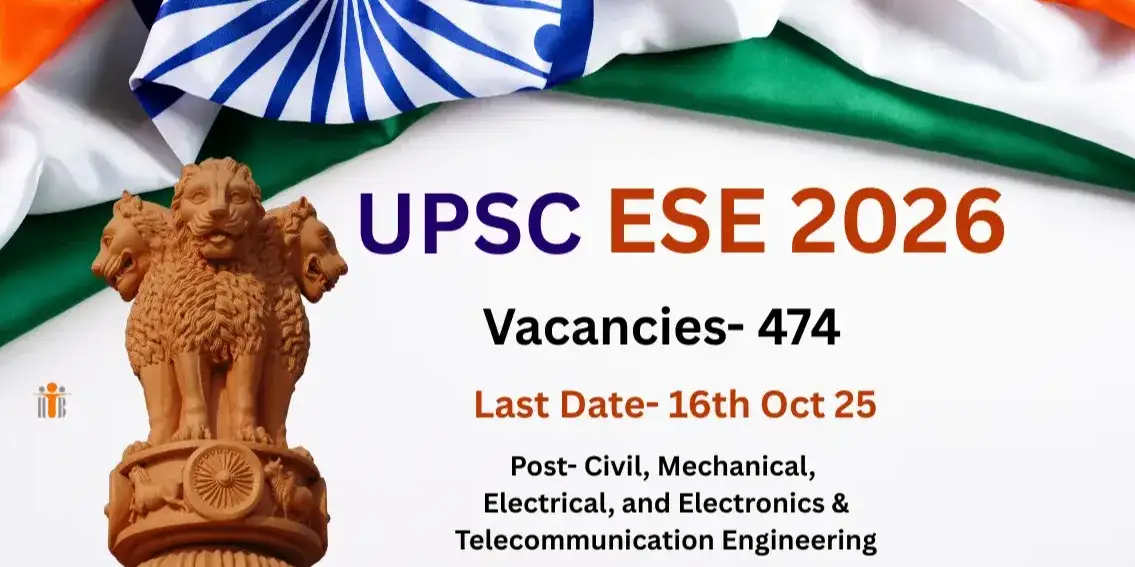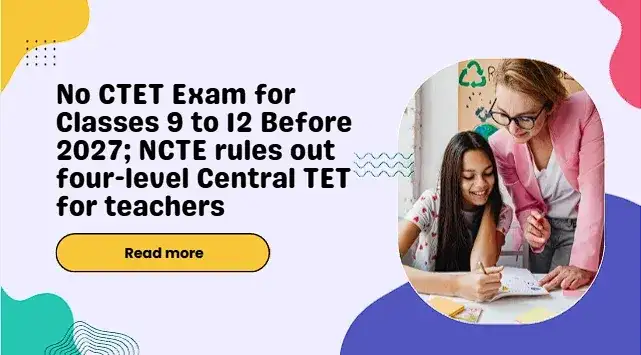As an aspiring engineer, I understand the excitement and anticipation that comes with the release of the Engineering Services Examination 2026 notification.
The Union Public Service Commission has officially announced 474 vacancies for engineering posts, and candidates can now apply online from 26th September to 16th October 2025.
With the preliminary exam scheduled for 8th February 2026, it's crucial to check the eligibility criteria before applying.
I feel that this is a great opportunity for engineers to join various government departments and organizations.
Key Takeaways
- The UPSC ESE 2026 notification has been released on 26th September.
- A total of 474 vacancies have been announced for engineering posts.
- Candidates can apply online from 26th September to 16th October 2025.
- The preliminary exam is scheduled to be conducted on 8th February 2026.
- Candidates must check the eligibility criteria before applying online.
UPSC ESE 2026 Notification: Breaking Down the Announcement
The UPSC ESE 2026 notification has been released, and it's time to dive into the details of this significant announcement. The Engineering Services Examination (ESE) is a prestigious exam conducted by the Union Public Service Commission (UPSC) for recruiting engineers into various government departments.
Key Highlights of the Engineering Services Examination
The UPSC ESE 2026 exam is designed to test a candidate's comprehensive understanding of General Studies, Engineering Aptitude, and their core engineering subjects. The exam covers various disciplines, including Civil, Mechanical, Electrical, and Electronics & Telecommunication Engineering. Candidates must apply online through the UPSC website.
The selection process comprises three stages: Preliminary Examination, Main Examination, and Personality Test. The preliminary exam is an objective-type test, while the mains exam is a descriptive-type test.
Engineering Category |
|---|
Category I – Civil Engineering |
Category II – Mechanical Engineering |
Category III – Electrical Engineering |
Category IV – Electronics & Telecommunication Engineering |
UPSC as the Conducting Authority
The UPSC is responsible for conducting the ESE, ensuring a fair and transparent selection process. The commission adheres to a strict schedule, releasing notifications and updates on its official website. Candidates are advised to regularly check the UPSC website for the latest updates on the ese exam pattern 2026 and upsc ese syllabus 2026.
For the latest information on the Engineering Services Examination, candidates can visit the UPSC website and stay updated with the engineering services exam 2026 latest updates.
474 Vacancies Announced: Discipline-wise Distribution
The Union Public Service Commission (UPSC) has released the notification for ESE 2026, with 474 vacancies across multiple engineering fields. The vacancies are distributed across various engineering disciplines, providing opportunities for candidates from different engineering backgrounds.
Civil Engineering Opportunities
Civil Engineering candidates have a significant number of vacancies available. The total number of posts for Civil Engineering is substantial, making it a viable option for many aspirants.
Mechanical Engineering Positions
Mechanical Engineers can also apply for the ESE 2026, with a considerable number of vacancies announced. The Mechanical Engineering posts are among the most sought after in the Engineering Services Examination.
Electrical Engineering Openings
Electrical Engineering candidates have numerous opportunities with a notable number of vacancies. The Electrical Engineering discipline is well-represented in the ESE 2026 notification.
Electronics & Telecommunication Vacancies
For Electronics & Telecommunication Engineers, there are also multiple vacancies available. This discipline is an integral part of the Engineering Services Examination, offering various posts for qualified candidates.
The distribution of vacancies across these engineering disciplines highlights the diverse opportunities available through the ESE 2026. Candidates should review the official notification to understand the specific number of vacancies and eligibility criteria for their respective engineering branches.
Eligibility Requirements for ESE 2026 Aspirants
Understanding the eligibility requirements is crucial for candidates applying for UPSC ESE 2026. The Union Public Service Commission (UPSC) has set specific criteria that aspirants must meet to be eligible for the Engineering Services Examination (ESE) 2026.
Age Limit: 21-30 Years Bracket
The age limit for UPSC ESE 2026 is between 21 and 30 years as of August 1, 2026. This means candidates must have been born between August 2, 1996, and August 1, 2005, to be eligible. Age relaxation is available for certain categories as per government norms.
Educational Qualifications Needed
Candidates must possess a bachelor's degree in engineering or technology from a recognized university or institution. The degree must be in the relevant discipline for the posts applied for.
Accepted Engineering Degrees
Accepted degrees include BE/BTech in relevant engineering streams such as Civil, Mechanical, Electrical, and Electronics & Telecommunication. The degree should be from an institution recognized by the Ministry of Education, Government of India.
Equivalent Qualification Considerations
Equivalent qualifications recognized by the Government of India are also considered eligible. Candidates with such qualifications should provide relevant certificates during the application process.
Nationality and Citizenship Criteria
Candidates must be citizens of India to be eligible for the UPSC ESE 2026 exam. Proof of citizenship may be required during the application or selection process. The nationality criteria are strictly adhered to, and only Indian citizens are eligible to apply.
Critical Dates for UPSC ESE 2026 Examination Cycle
The UPSC ESE 2026 examination cycle is approaching, and it's crucial to be aware of the critical dates. Candidates must stay updated on these dates to ensure they don't miss important deadlines.
Application Timeline: October 16, 2025 Deadline
The application process for UPSC ESE 2026 begins on September 26, 2025, and ends on October 16, 2025. It's essential for candidates to apply within this timeframe to be eligible for the examination. As per the official notification, candidates should fill out the application form carefully and submit it before the deadline.
Preliminary Examination: February 8, 2026
The preliminary examination for UPSC ESE 2026 is scheduled to take place on February 8, 2026. This exam is the first stage of the selection process, and candidates must prepare thoroughly to qualify for the next stage.
Expected Dates for Main Examination and Interview
While the exact dates for the main examination and interview have not been officially announced, candidates can expect them to follow the preliminary examination. Typically, the main examination is conducted a few months after the preliminary exam, followed by an interview for those who qualify. As quoted by the UPSC, "The Commission will notify the details of the examination schedule in due course."
Candidates are advised to regularly check the official UPSC website for updates on the examination schedule to stay informed and plan their preparation accordingly.
Step-by-Step Application Process via upsc.gov.in
To apply for the UPSC ESE 2026 exam, candidates must follow a step-by-step online application process via upsc.gov.in. The process involves several key steps that must be completed accurately to ensure a successful application.
Creating UPSC Profile and Registration
The first step in the application process is creating a UPSC profile and registration. Candidates need to visit the UPSC website and register by providing basic information such as name, email address, and mobile number. Upon registration, candidates will receive a unique registration ID, which is essential for filling out the application form.
Filling the Online Application Form
After registration, candidates can log in and fill out the UPSC ESE 2026 application form. It is crucial to have all necessary documents ready, including educational certificates and identity proof, to fill in the required details accurately. The form will ask for personal and educational information, so candidates should have all relevant details handy.
Document Upload Requirements and Specifications
Candidates must upload scanned copies of required documents, such as their signature, photograph, and educational certificates. The UPSC website provides specific guidelines on the file format and size for these uploads, which must be followed carefully to avoid any issues.
Application Submission and Confirmation
After filling out the application form and uploading the necessary documents, candidates must review their application carefully before submitting it. Upon successful submission, candidates will receive a confirmation message. It is advisable to print or save a copy of the submitted application for future reference.
Fee Structure and Payment Methods
Understanding the fee structure for UPSC ESE 2026 is crucial for aspiring candidates. The Union Public Service Commission (UPSC) has specified the application fee for the Engineering Services Examination (ESE) 2026.
Category-wise Fee Details: ₹200 for General/OBC
The application fee for UPSC ESE 2026 is ₹200 for candidates belonging to the General and OBC categories. This fee is a necessary part of the application process, and candidates must pay it to successfully submit their applications.
Fee Exemptions for SC/ST/PwD/Women Candidates
Candidates from SC, ST, PwD, and women categories are exempt from paying the application fee. This exemption is in line with the UPSC's policies to ensure equal opportunities for all candidates.
Online Payment Options: Cards, UPI, and Net Banking
The UPSC provides various online payment options for candidates to pay the application fee. These include payment through cards, UPI, and net banking, making it convenient for candidates to complete the payment process.
Category | Fee |
|---|---|
General/OBC | ₹200 |
SC/ST/PwD/Women | Exempt |
It's essential for candidates to review the fee structure and payment options carefully to avoid any issues during the application process.
Three-Stage Selection Process Explained
The UPSC ESE 2026 selection process is a three-stage journey that requires strategic preparation. Candidates must clear each stage to move forward, making it essential to understand the ese exam pattern 2026 and upsc ese syllabus 2026.
Preliminary Examination: Objective Pattern
The preliminary examination is the first hurdle in the engineering services examination 2026. It consists of two papers:
General Studies and Engineering Aptitude Paper
This paper tests a candidate's general awareness and engineering aptitude. It includes questions on various subjects, including engineering disciplines.
Engineering Discipline-Specific Paper
Candidates must choose a specific engineering discipline and answer questions related to that field. This paper assesses their technical knowledge and understanding.
Main Examination: Descriptive Format
The main examination is a descriptive-type test that evaluates a candidate's in-depth knowledge of their chosen engineering discipline. It consists of:
Technical Papers Structure
The main examination includes two compulsory papers that are discipline-specific. These papers test a candidate's technical expertise and problem-solving skills.
Marking Scheme and Qualifying Criteria
Candidates must score a minimum qualifying mark to pass the main examination. The marking scheme is designed to assess their technical knowledge, analytical skills, and ability to communicate complex ideas effectively.
Personality Test: Interview Assessment
The final stage is a personality test or interview, which assesses a candidate's communication skills, personality traits, and suitability for a career in engineering services. The interview panel evaluates their attitude, confidence, and overall demeanor.
Admit Card Release and Examination Centers
As the UPSC ESE 2026 examination approaches, candidates are eagerly awaiting the release of their admit cards. The admit card is a crucial document that candidates must carry to the examination center along with a valid photo ID proof.
Downloading Admit Cards from UPSC Portal
Candidates can download their admit cards from the official UPSC website using their registration number or roll number. The admit card download process is straightforward and requires candidates to log in with their credentials.
Step-by-Step Admit Card Download Process:
- Log in to the UPSC official website using your credentials.
- Navigate to the UPSC ESE 2026 admit card section.
- Enter your registration number/roll number and date of birth.
- Download and print your admit card.
Examination Center Allocation Process
The UPSC allocates examination centers based on the candidates' preferences and availability. Candidates are advised to check their admit cards carefully for the allocated examination center, date, and time.
Important Instructions for Examination Day
On the day of the examination, candidates must reach the examination center well in advance. Here are some important instructions to follow:
Item | Description |
|---|---|
Admit Card | Carry a printed copy of your admit card. |
Photo ID Proof | Carry a valid photo ID proof (e.g., Aadhaar, PAN card, Passport). |
Stationery | Carry necessary stationery items (e.g., pens, pencils, eraser). |
By following these instructions, candidates can ensure a smooth examination experience.
Career Prospects After Clearing UPSC ESE 2026
Clearing UPSC ESE 2026 opens doors to numerous career opportunities in engineering services. Candidates who succeed in this examination can expect to be allocated to various prestigious government departments.
Service Allocations and Departments
After clearing the exam, candidates are allocated to different engineering services based on their preferences and merit. These services include Civil, Mechanical, Electrical, and Electronics & Telecommunication Engineering. The allocation is made according to the vacancies available and the candidate's rank.
Engineering Service | Departments |
|---|---|
Civil Engineering | Central Engineering Services, Public Works Department |
Mechanical Engineering | Indian Railway Mechanical Engineering Service, Central Mechanical Engineering Service |
Electrical Engineering | Indian Railway Electrical Engineering Service, Central Electrical Engineering Service |
Pay Scales and Growth Opportunities
The pay scales for UPSC ESE selected candidates are attractive, with a starting pay scale in the Pay Band 3 (₹15,600 - ₹39,100) with a Grade Pay of ₹5,400 or higher, depending on the service and department. There are also numerous growth opportunities, with promotions to higher grades based on experience and performance.
Training Period and Probation
After selection, candidates undergo a compulsory training period, which varies depending on the service. This is followed by a probation period during which their performance is evaluated. Successful completion of both phases confirms their appointment to the respective engineering services.
Conclusion: Your Roadmap to Success in Engineering Services
As I reflect on the UPSC ESE 2026 notification, it's clear that this is a crucial step towards a successful career in engineering services. The Union Public Service Commission (UPSC) has announced 474 vacancies for the Engineering Services Examination (ESE) 2026, and candidates must prepare thoroughly for the exam.
To succeed, it's essential to understand the eligibility criteria, exam pattern, and selection process outlined in the UPSC ESE 2026 notification. By meeting the requirements and staying informed about critical dates, such as the application deadline of October 16, 2025, and the preliminary examination on February 8, 2026, candidates can navigate the process with confidence.
The UPSC ESE 2026 examination is a three-stage process, consisting of a preliminary examination, main examination, and personality test. By understanding the exam pattern and selection process, candidates can focus their preparation and increase their chances of success in the engineering services examination 2026.
With the upsc 2026 notification as a guide, candidates can create a roadmap for success in engineering services. I encourage all aspiring engineers to stay focused, prepare diligently, and take the first step towards a rewarding career in engineering services.







Comments(0)